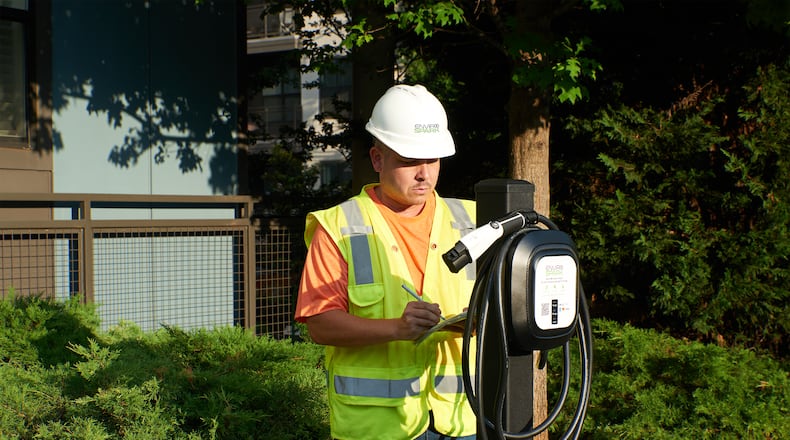The Georgia economy rolled through the Federal Reserve’s stop sign in February, adding 3,200 jobs as the unemployment rate remained near a historic low.
While growth was slightly slower than the state’s pre-pandemic average for the month, the jobless rate was 3.1% for the sixth consecutive month, even as the number of people looking for work increased.
For many growing companies — especially in the state’s surging electric vehicle industry — the Fed’s campaign to slow the economy with higher rates has barely registered.
EnviroSpark, which installs charging stations for electric vehicles, has gone from 15 employees to 106 in two years, hiring a wide range of skills, including electricians, technicians, project managers and sales staff, said Aaron Luque, chief executive.
The Atlanta-based company expects to keep expanding, whatever happens to interest rates, he said. “In the EV sector, there is no end in sight for opportunity. We have had the luxury of being somewhat insulated.”
For much of 2022, companies complained about a shortage of workers.
Then in recent months, a slew of tech companies announced layoffs, including Twitter, Amazon, Meta, Salesforce and Greenlight Financial. Many of those cuts have been in metro Atlanta, spurring worries about recession.
Yet unemployment has not risen, partly because other companies snapped up those workers.
“It was very tough to find good people about six months ago and then, all of a sudden, those layoffs happened,” Luque said.
Other new technologies are also growing. On Thursday, the state announced plans by Hanwha Advanced Materials to invest $147 million and hire 160 workers in Cartersville as part of plans to supply the Qcells plant making solar cells.
Three years after the start of the pandemic, each major sector has regained all lost jobs, according to Bruce Thompson, state labor commissioner.
Overall, the state has 198,100 more jobs than in Feb. 2020.
Robust hiring has meant a reversal in the pandemic-spurred exodus of women from the workforce, a flow caused partly by the closure of most childcare centers. But the number of childcare programs has rebounded and is now about the same as pre-pandemic, according to Reg Griffin, spokesman for the Georgia Department of Early Care and Learning.
The pandemic and the subsequent labor shortage has meant higher wages, as well as more choice in hours and remote work, said James Taylor, senior regional director for staffing company Robert Half International. “Women in the workforce have leverage like they never had before. The number one motivation is pay, but they are also looking for greater flexibility and more status.”
Women average wage increases at a 6.1%-a-year pace — the same as men, according to the most recent data from the Atlanta Federal Reserve’s wage tracker.
Inflation has fallen, but is still higher than the Fed’s target. So, the Fed has continued its 16-month campaign of rate hikes. This month, the failure of Silicon Valley Bank triggered worry about a looming financial crisis that could crimp the ability of growing companies to get the loans they need to hire.
Yet the Georgia economy keeps pushing forward.
Among sectors expanding last month were retail, construction, trade contractors, government and wholesalers. Meanwhile, more than 120,000 listings are on the state’s job board, with healthcare, hospital and retail the most common, Thompson said.
Still, there are signs that growth is decelerating, with the number of openings declining slowly. Moreover, by some measures, the labor market has not completely regained its health and there are signs that some workers are struggling.
The labor force — everyone either working or actively looking for work — has grown by 25,197 in the past 12 months, but is still smaller than if growth had continued at its pre-pandemic pace.
The share of working-age people with jobs in Georgia is 61.0%. That’s the highest in the Southeast, but is lower than it was three years ago and is lower than the current national average.
And while women have come back to the workforce, their participation is still nearly 10 percentage points lower than that of men, according to the Bureau of Labor Statistics.
Moreover, inflation may be pushing some people to work harder than they want to, according to Daniel Altman, chief economist for Instawork, which connects businesses with people looking for flexible, hourly jobs like warehousing, logistics and hospitality.
Instawork users in Atlanta averaged 68 hours last month, compared to 53 nationally, he said. “Inflation has been higher in Atlanta than elsewhere, which can be a problem for folks that don’t have white-collar jobs.”
Georgia job growth, February
Average, pre-pandemic: 4,300 jobs
Average, previous 10 years: 7,500
Recent: 3,200 jobs (2023)
Georgia unemployment rate
Lowest, pre-pandemic: 3.4% (Nov., Dec., 2000)
Lowest, since pandemic: 3.0% (June, July 2022)
Recent: 3.1% (Feb. 2023)
Georgia labor participation rate
Pre-pandemic high: 69.3% (Nov., Dec., 1998)
Pre-pandemic: 62.9% (Feb. 2020)
Recent: 61.0% (Feb. 2023)
Sources: Georgia Department of Labor, Bureau of Labor Statistics, Federal Reserve Bank of St. Louis
____________________
About the Author
Keep Reading
The Latest
Featured

